Optimization Design of Cotton-Straw-Fiber-Modified Asphalt Mixture Performance Based on Response Surface Methodology
Abstract
1. Introduction
2. Materials and Test Methods
2.1. Raw Materials
2.2. Test Methods
2.3. Test Design
3. Results and Analysis
3.1. Statistical Analysis
| Source | Sum of Squares | Df | Mean Square | F-Value | p-Value | |
|---|---|---|---|---|---|---|
| Stability | ||||||
| Model | 6.55 | 9 | 0.7278 | 42.11 | <0.0001 | Significant |
| A | 1.61 | 1 | 1.61 | 93.20 | <0.0001 | Significant |
| B | 0.1568 | 1 | 0.1568 | 9.07 | 0.0196 | Significant |
| C | 0.1128 | 1 | 0.1128 | 6.53 | 0.0378 | Significant |
| AB | 0.0025 | 1 | 0.0025 | 0.1446 | 0.7150 | |
| AC | 0.0012 | 1 | 0.0012 | 0.0709 | 0.7978 | |
| BC | 0.0016 | 1 | 0.0016 | 0.0926 | 0.7698 | |
| A2 | 0.2089 | 1 | 0.2089 | 12.09 | 0.0103 | Significant |
| B2 | 0.0466 | 1 | 0.0466 | 2.70 | 0.1445 | |
| C2 | 4.53 | 1 | 4.53 | 262.06 | <0.0001 | Significant |
| Residual | 0.1210 | 7 | 0.0173 | |||
| Lack of Fit | 0.0339 | 3 | 0.0113 | 0.5194 | 0.6913 | Not significant |
| Pure Error | 0.0871 | 4 | 0.0218 | |||
| Cor Total | 6.67 | 16 | ||||
| Std. Dev. | 0.1315 | C.V. % | 1.06 | Adeq Precision | 23.2177 | |
| R2 | 0.9819 | Adjusted R2 | 0.9585 | Predicted R2 | 0.8982 | |
| Dynamic Stability | ||||||
| Model | 2.75 × 106 | 9 | 3.056 × 105 | 58.75 | <0.0001 | Significant |
| A | 85,822.25 | 1 | 85,822.25 | 16.50 | 0.0048 | Significant |
| B | 2.113 × 105 | 1 | 2.113 × 105 | 40.63 | 0.0004 | Significant |
| C | 4455.68 | 1 | 4455.68 | 0.8566 | 0.3855 | |
| AB | 5184.00 | 1 | 5184.00 | 0.9966 | 0.3514 | |
| AC | 98,219.56 | 1 | 98,219.56 | 18.88 | 0.0034 | Significant |
| BC | 7191.04 | 1 | 7191.04 | 1.38 | 0.2781 | |
| A2 | 5.390 × 105 | 1 | 5.390 × 105 | 103.63 | <0.0001 | Significant |
| B2 | 1.236 × 106 | 1 | 1.236 × 106 | 237.66 | <0.0001 | Significant |
| C2 | 3.390 × 105 | 1 | 3.390 × 105 | 65.17 | <0.0001 | Significant |
| Residual | 36,410.69 | 7 | 5201.53 | |||
| Lack of Fit | 11,897.17 | 3 | 3965.72 | 0.6471 | 0.6246 | Not significant |
| Pure Error | 24,513.52 | 4 | 6128.38 | |||
| Cor Total | 2.787 × 106 | 16 | ||||
| Std. Dev. | 72.12 | C.V. % | 3.51 | Adeq Precision | 21.7257 | |
| R2 | 0.9869 | Adjusted R2 | 0.9701 | Predicted R2 | 0.9179 | |
| Low-Temperature Tensile Strength | ||||||
| Model | 8.82 | 9 | 0.9801 | 20.39 | 0.0003 | |
| A | 1.01 | 1 | 1.01 | 20.97 | 0.0025 | Significant |
| B | 0.1800 | 1 | 0.1800 | 3.74 | 0.0942 | |
| C | 0.0098 | 1 | 0.0098 | 0.2039 | 0.6653 | |
| AB | 0.0025 | 1 | 0.0025 | 0.0520 | 0.8261 | |
| AC | 0.0144 | 1 | 0.0144 | 0.2995 | 0.6012 | |
| BC | 0.0529 | 1 | 0.0529 | 1.10 | 0.3290 | |
| A2 | 2.45 | 1 | 2.45 | 50.99 | 0.0002 | Significant |
| B2 | 4.24 | 1 | 4.24 | 88.11 | <0.0001 | Significant |
| C2 | 0.2590 | 1 | 0.2590 | 5.39 | 0.0533 | |
| Residual | 0.3365 | 7 | 0.0481 | |||
| Lack of Fit | 0.0220 | 3 | 0.0073 | 0.0933 | 0.9599 | |
| Pure Error | 0.3145 | 4 | 0.0786 | |||
| Cor Total | 9.16 | 16 | ||||
| Std. Dev. | 0.2193 | C.V. % | 1.90 | Adeq Precision | 13.3560 | |
| R2 | 0.9633 | Adjusted R2 | 0.9160 | Predicted R2 | 0.9079 | |
| Freeze–Thaw Strength Ratio | ||||||
| Model | 241.45 | 9 | 26.83 | 67.20 | <0.0001 | Significant |
| A | 3.25 | 1 | 3.25 | 8.14 | 0.0246 | Significant |
| B | 8.41 | 1 | 8.41 | 21.05 | 0.0025 | Significant |
| C | 15.40 | 1 | 15.40 | 38.58 | 0.0004 | Significant |
| AB | 0.7225 | 1 | 0.7225 | 1.81 | 0.2205 | |
| AC | 0.3600 | 1 | 0.3600 | 0.9018 | 0.3739 | |
| BC | 1.56 | 1 | 1.56 | 3.91 | 0.0884 | |
| A2 | 52.91 | 1 | 52.91 | 132.54 | <0.0001 | Significant |
| B2 | 95.80 | 1 | 95.80 | 239.98 | <0.0001 | Significant |
| C2 | 41.65 | 1 | 41.65 | 104.32 | <0.0001 | Significant |
| Residual | 2.79 | 7 | 0.3992 | |||
| Lack of Fit | 0.1425 | 3 | 0.0475 | 0.0716 | 0.9721 | Not significant |
| Pure Error | 2.65 | 4 | 0.6630 | |||
| Cor Total | 244.24 | 16 | ||||
| Std. Dev. | 0.6318 | C.V. % | 0.7176 | Adeq Precision | 21.4664 | |
| R2 | 0.9886 | Adjusted R2 | 0.9738 | Predicted R2 | 0.9737 | |
3.2. Stability Analysis
3.3. High-Temperature Performance Analysis
3.4. Low-Temperature Performance Analysis
3.5. Water Stability Performance Analysis
4. Model Validation and Performance Comparison
4.1. Model Validation
4.2. Performance Comparison
5. Conclusions
- Performance gains are noticeable when cotton straw fibers are added to asphalt mixes. The optimal parameter combination derived from the predictive model was as follows: 0.28% fiber content, 6.26 mm fiber length, and 5.35% asphalt content. Under this combination, the optimal Marshall stability was 12.246 kN, dynamic stability was 2452.396 times/mm, flexural tensile strength was 12.30 MPa, and the freeze–thaw strength ratio was 92.76%.
- The variance analysis reveals that the models for stability, dynamic stability, flexural tensile strength, and freeze–thaw strength ratio exhibit high F-values and low p-values (all < 0.05), indicating significant impacts and reliable model terms. The models show high R2 values (all > 0.95), minimal differences between Adjusted R2 and Predicted R2, and Adeq Precision values well above 4, demonstrating strong predictive power and robustness across all metrics. These results confirm the models’ reliability for effective predictions and optimization.
- Based on the optimization results, errors across all responses were less than 10%. This demonstrates that Response Surface Methodology (RSM) is highly effective and provides reliable predictions for designing and optimizing high-performance asphalt mixtures.
- When compared with both SBS-modified and untreated asphalt mixes, the cotton-straw-fiber-modified asphalt mixtures show better fatigue resistance. As the stress ratio increases, fatigue life declines for all mixtures, but cotton straw fibers significantly enhance performance by bridging microcracks and improving stress dissipation. This modification extends fatigue life more effectively than SBS, underscoring the substantial benefits of cotton straw fibers in enhancing asphalt mixture durability, especially under high-stress conditions.
- In this study, the performance of cotton-straw-fiber-modified asphalt mixtures was evaluated by experimental design. A method used to optimize the performance of modified asphalt mixtures was proposed for its popularization and application. The modification mechanism can be further investigated by carrying out microstructural analysis in subsequent studies.
Author Contributions
Funding
Data Availability Statement
Conflicts of Interest
References
- Radhakrishnan, S. Sustainable cotton production. In Sustainable Fibres and Textiles; Elsevier: Amsterdam, The Netherlands, 2017; pp. 21–67. [Google Scholar]
- Abd El-Sayed, E.S.; El-Sakhawy, M.; El-Sakhawy, M.A.-M. Non-wood fibers as raw material for pulp and paper industry. Nord. Pulp Pap. Res. J. 2020, 35, 215–230. [Google Scholar] [CrossRef]
- Hamawand, I.; Sandell, G.; Pittaway, P.; Chakrabarty, S.; Yusaf, T.; Chen, G.; Seneweera, S.; Al-Lwayzy, S.; Bennett, J.; Hopf, J. Bioenergy from cotton industry wastes: A review and potential. Renew. Sustain. Energy Rev. 2016, 66, 435–448. [Google Scholar] [CrossRef]
- Canestrari, F.; Ingrassia, L.P. A review of top-down cracking in asphalt pavements: Causes, models, experimental tools and future challenges. J. Traffic Transp. Eng. 2020, 7, 541–572. [Google Scholar] [CrossRef]
- Du, Y.; Chen, J.; Han, Z.; Liu, W. A review on solutions for improving rutting resistance of asphalt pavement and test methods. Constr. Build. Mater. 2018, 168, 893–905. [Google Scholar] [CrossRef]
- Li, W. Study on Performance of Asphalt Mixture with Cotton Stalk Fiber. Master’s Thesis, Chang’an University, Xi’an, China, 2015. [Google Scholar]
- Lei, T.; Li, Z.; Liu, K.; Zhao, H.; Li, W. Cotton straw fiber asphalt mixture road performance. Highway 2016, 7, 59–63. [Google Scholar]
- Tamburro, D.A. The effect of short chrysotile asbestos fibers on the structural properties of asphaltic pavenents. Proc. Ass. Asph. Pav. Technol 1962, 31, 151–175. [Google Scholar]
- Bernstein, D.M. The health effects of short fiber chrysotile and amphibole asbestos. Crit. Rev. Toxicol. 2022, 52, 89–112. [Google Scholar] [CrossRef]
- Osinubi, O.; Gochfeld, M.; Kipen, H.M. Health effects of asbestos and nonasbestos fibers. Environ. Health Perspect. 2000, 108, 665–674. [Google Scholar]
- Zhang, J.; Dong, X. Comparative study on the properties of different fiber-modified asphalts. Asian J. Adv. Res. Rep. 2024, 18 (Suppl. S4), 148–154. [Google Scholar] [CrossRef]
- Luo, D.; Khater, A.; Yue, Y.; Abdelsalam, M.; Zhang, Z.; Li, Y.; Li, J.; Iseley, D.T. The performance of asphalt mixtures modified with lignin fiber and glass fiber: A review. Constr. Build. Mater. 2019, 209, 377–387. [Google Scholar] [CrossRef]
- Li, Z.; Li, K.; Chen, W.; Liu, W.; Yin, Y.; Cong, P. Investigation on the characteristics and effect of plant fibers on the properties of asphalt binders. Constr. Build. Mater. 2022, 338, 127652. [Google Scholar] [CrossRef]
- Guo, Y.; Tataranni, P.; Sangiorgi, C. The use of fibres in asphalt mixtures: A state of the art review. Constr. Build. Mate.R 2023, 390, 131754. [Google Scholar] [CrossRef]
- Li, Z.; Guo, T.; Chen, Y.; Liu, J.; Ma, J.; Wang, J.; Jin, L. Study on pavement performance of cotton straw cellulose modified asphalt. Mater. Res. Express 2022, 9, 025508. [Google Scholar] [CrossRef]
- Yu, X.; Li, G.; Zhao, H.; Ma, Y.; Li, Q.; Chen, Y.; Li, W. Influence of chemically-modified cotton straw fibers on the properties of asphalt mortar. Case Stud. Constr. Mater. 2023, 18, e01787. [Google Scholar] [CrossRef]
- Zhao, H.; Li, G.; Ma, Y.; Yu, X.; Chen, Y.; Li, W. Long-term performance of chemically modified cotton straw fibers in micro-surfacing asphalt mixtures. Case Stud. Constr. Mater. 2024, 20, e03294. [Google Scholar] [CrossRef]
- Qiang, X.; Lei, L.; Yi-jun, C. Study on the action effect of pavement straw composite fiber material in asphalt mixture. Constr. Build. Mater. 2013, 43, 293–299. [Google Scholar] [CrossRef]
- Fu, S.-Y.; Lauke, B. Effects of fiber length and fiber orientation distributions on the tensile strength of short-fiber-reinforced polymers. Compos. Sci. Technol. 1996, 56, 1179–1190. [Google Scholar] [CrossRef]
- Liu, J.; Li, Z.; Chen, H.; Guan, B.; Liu, K. Investigation of cotton straw fibers for asphalt mixtures. J. Mater. Civil. Eng. 2020, 32, 04020105. [Google Scholar] [CrossRef]
- JTG E20-2011; Standard Test Methods of Bitumen and Bituminous Mixtures for Highway Engineering. People’s Transportation Press: Beijing, China, 2011.
- Bezerra, M.A.; Santelli, R.E.; Oliveira, E.P.; Villar, L.S.; Escaleira, L.A. Response surface methodology (RSM) as a tool for optimization in analytical chemistry. Talanta 2008, 76, 965–977. [Google Scholar] [CrossRef]
- Lapian, F.E.; Ramli, M.I.; Pasra, M.; Arsyad, A. The performance modeling of modified asbuton and polyethylene terephthalate (PET) mixture using response surface methodology (RSM). Appl. Sci. 2021, 11, 6144. [Google Scholar] [CrossRef]
- Guo, F.; Li, R.; Lu, S.; Bi, Y.; He, H. Evaluation of the Effect of Fiber Type, Length, and Content on Asphalt Properties and Asphalt Mixture Performance. Materials 2020, 13, 1556. [Google Scholar] [CrossRef] [PubMed]
- Fang, B.; Chang, D.; Xu, Z.; Gao, C. A review on graphene fibers: Expectations, advances, and prospects. Adv. Mater. 2020, 32, 1902664. [Google Scholar] [CrossRef] [PubMed]
- Zhang, M.; Hu, Z.; Zhao, J.; Li, H.; Zhang, J.; Lyu, L.; Wang, X.; Niu, Z.; Cai, J.; Pei, J. Components optimization of polyurethane-modified asphalt binder towards compatibility: Insight from molecular dynamics simulations. Constr. Build. Mater. 2024, 448, 138229. [Google Scholar] [CrossRef]
- Capela, C.; Oliveira, S.; Pestana, J.; Ferreira, J. Effect of fiber length on the mechanical properties of high dosage carbon reinforced. Procedia Struct. Integr. 2017, 5, 539–546. [Google Scholar] [CrossRef]
- Roustaei, M.; Eslami, A.; Ghazavi, M. Effects of freeze–thaw cycles on a fiber reinforced fine grained soil in relation to geotechnical parameters. Cold Reg. Sci. Technol. 2015, 120, 127–137. [Google Scholar] [CrossRef]
- Ye, Q.; Wu, S.; Li, N. Investigation of the dynamic and fatigue properties of fiber-modified asphalt mixtures. Int. J. Fatigue 2009, 31, 1598–1602. [Google Scholar] [CrossRef]

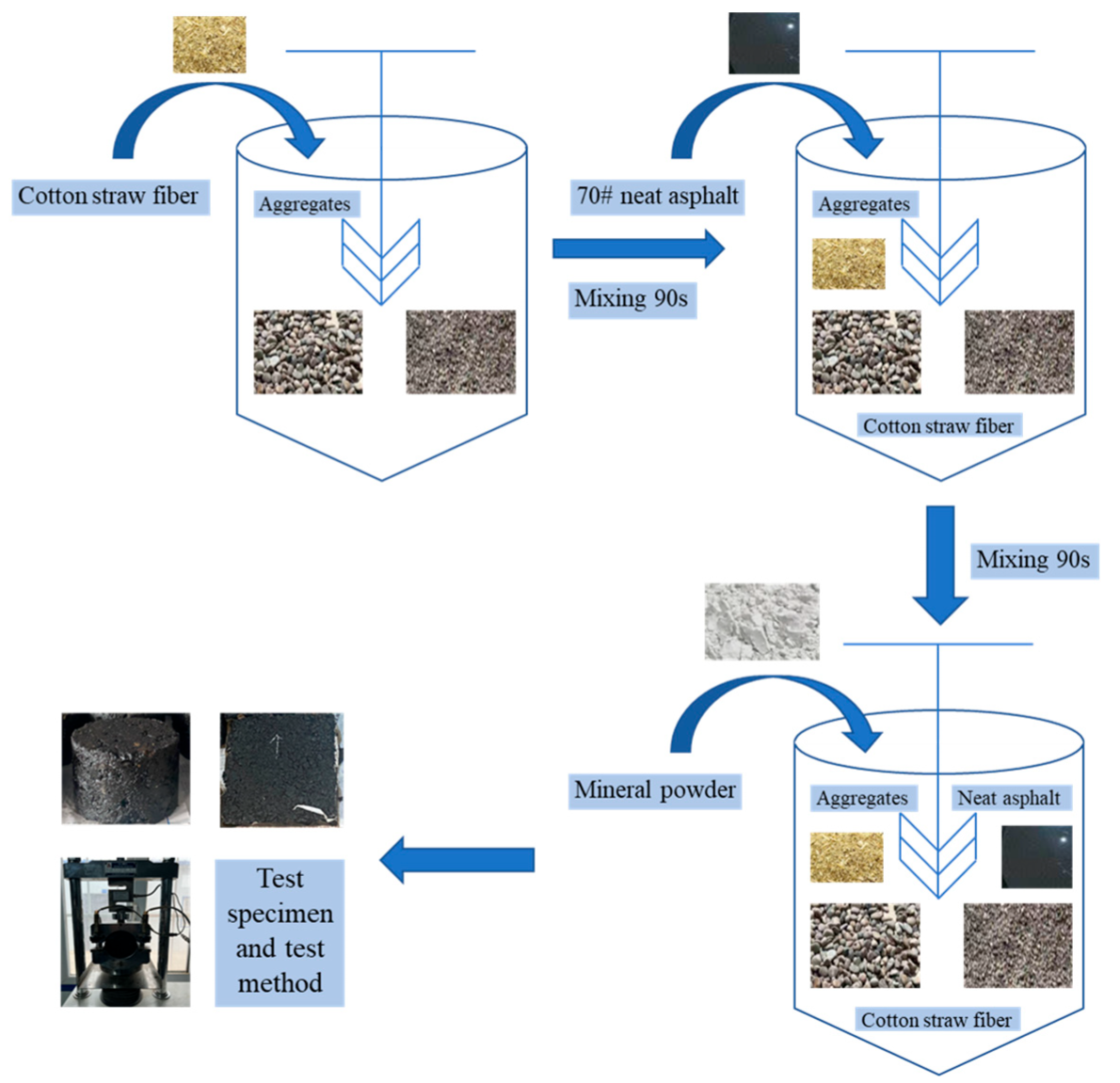
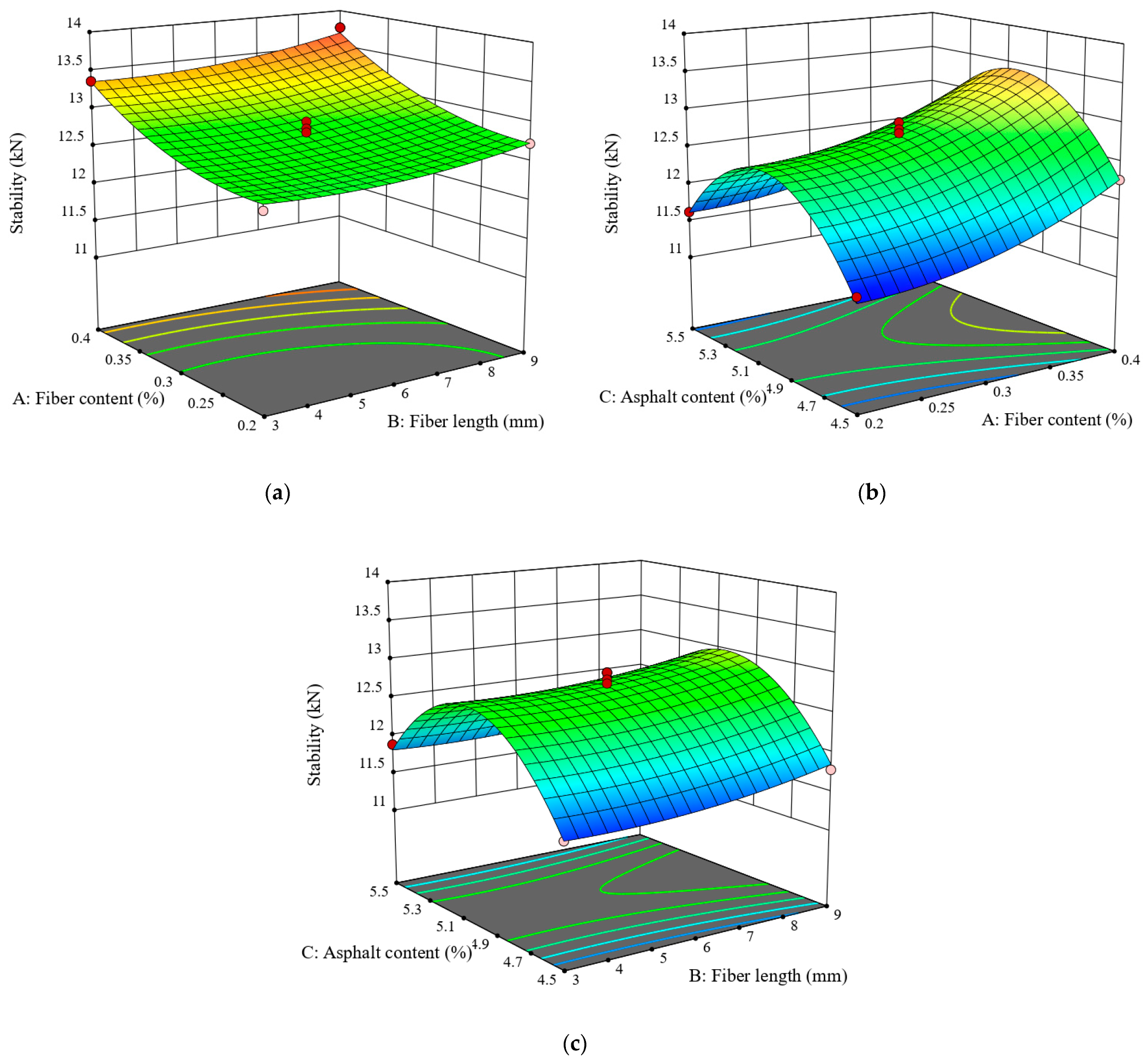
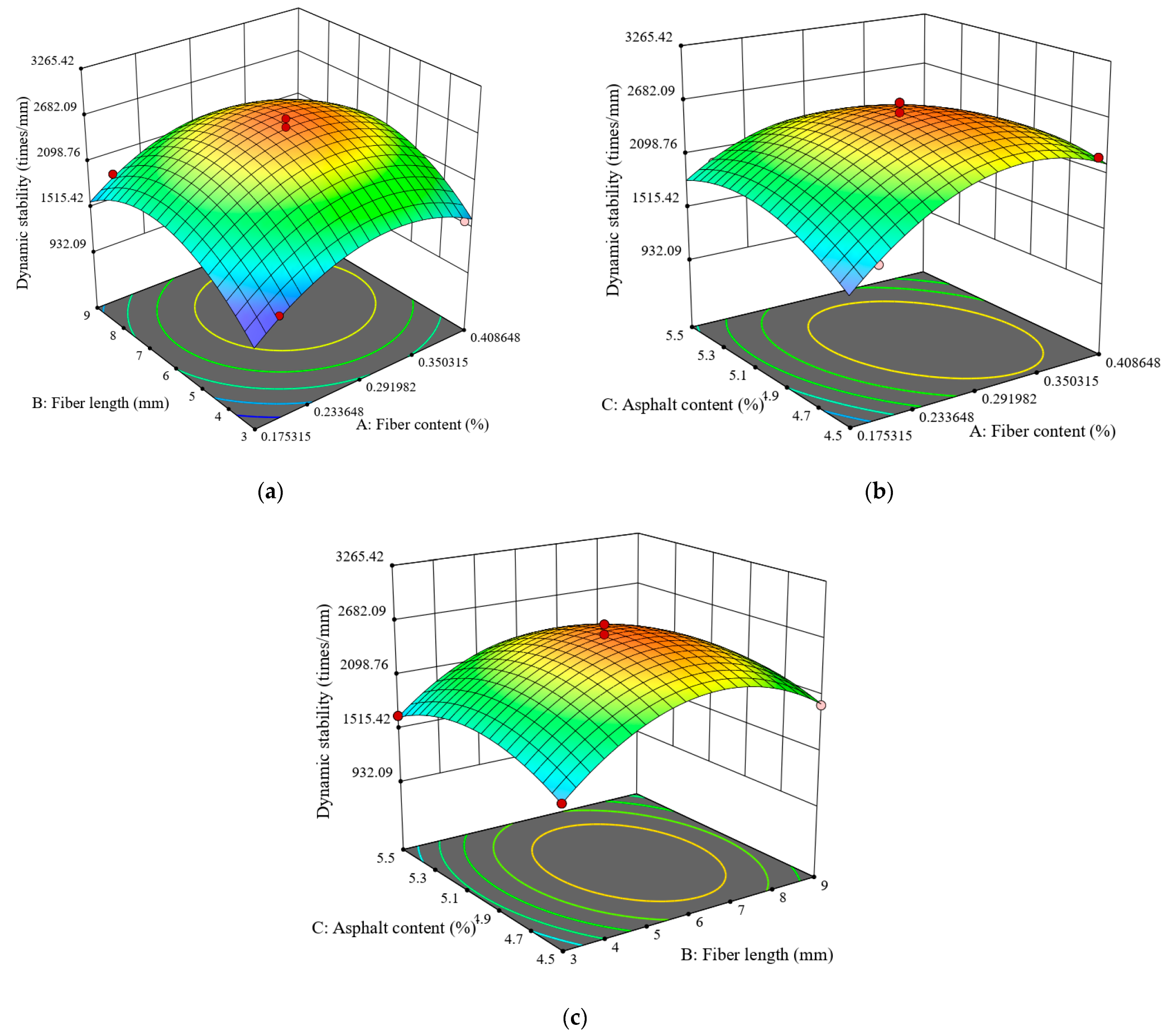

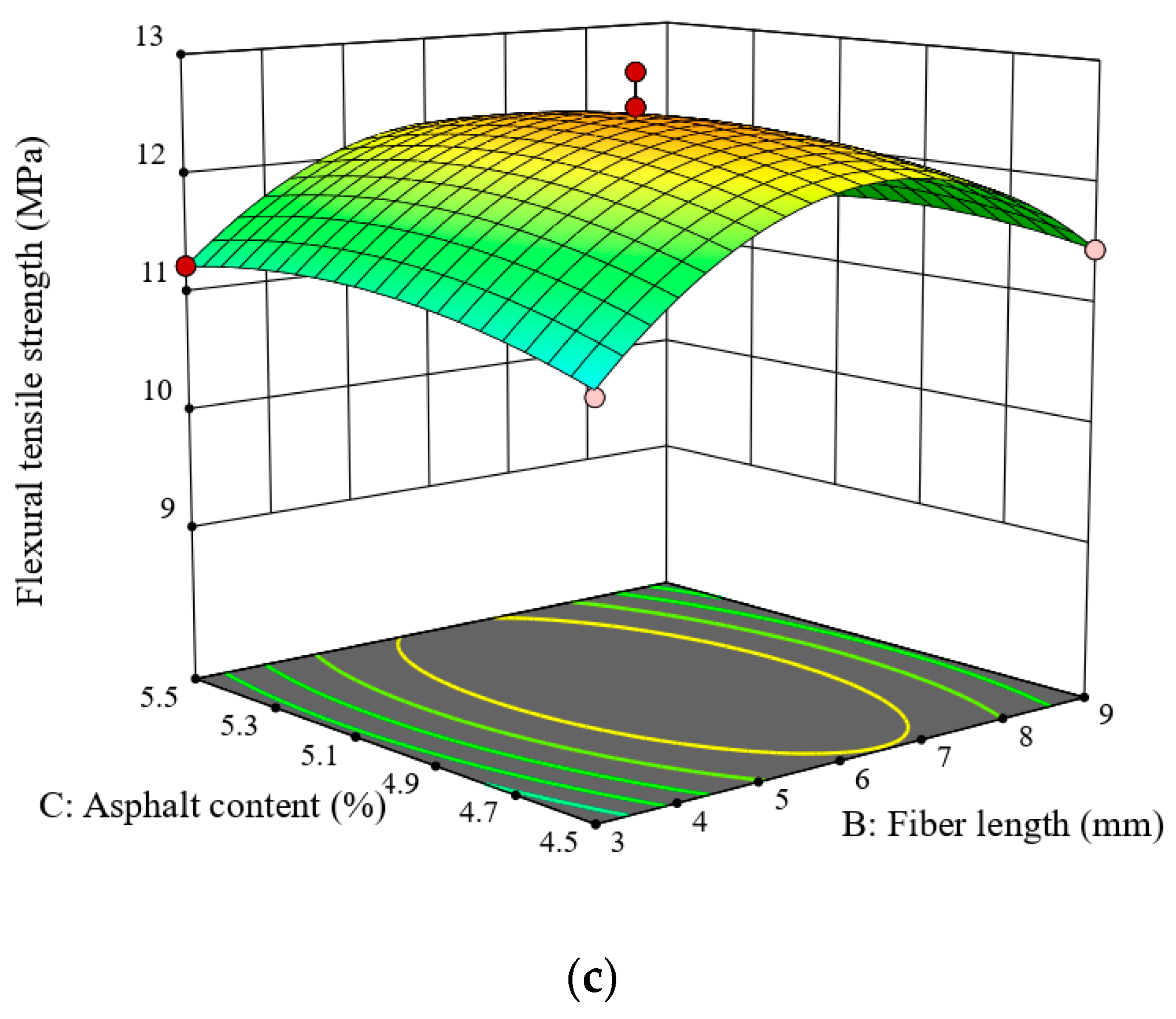

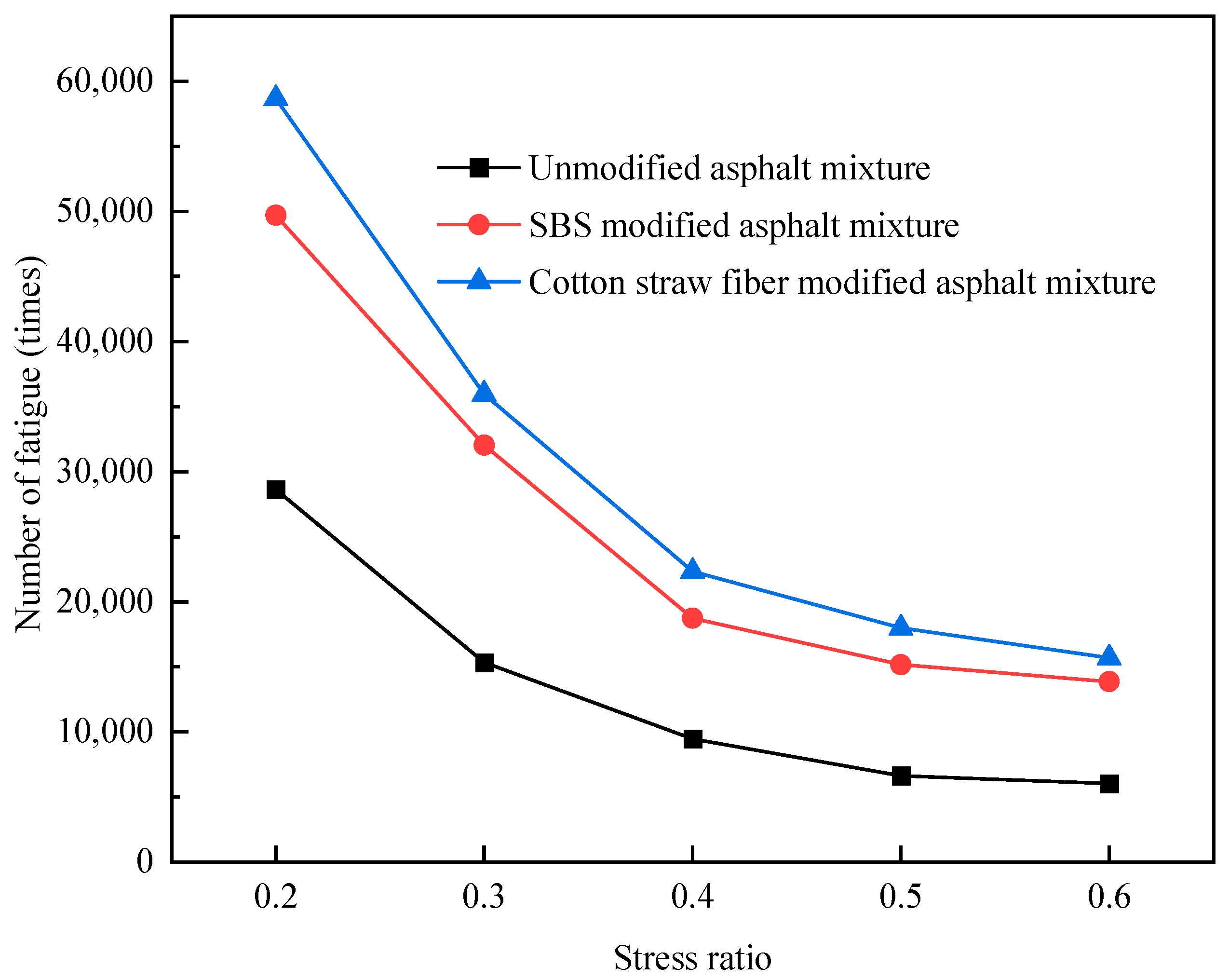
| Performance Indicator | Unit | Test Result | Test Method |
|---|---|---|---|
| Penetration | 0.1 mm | 75 | T0604-2011 |
| Softening point | °C | 54 | T0606-2011 |
| Ductility | cm | 178 | T0605-2011 |
| Density | g/cm3 | 1.02 | T0603-2011 |
| Flash point | °C | 285 | T0611-2011 |
| Aggregate Size (mm) | Apparent Specific Gravity | Bulk Specific Gravity | Crushing Value | Water Absorption |
|---|---|---|---|---|
| 9.5–16 | 2.735 | 2.674 | - | 0.74 |
| 4.75–9.5 | 2.743 | 2.641 | 15.8 | 0.84 |
| 2.36–4.75 | 2.684 | - | - | 0.88 |
| 0–2.36 | 2.658 |
| Index | Test Result | Test Method |
|---|---|---|
| Color | Brown | Visual assessment |
| Water absorption (%) | 2.8 | Cooling and weighing in an oven at 105 °C for 2 h |
| Ash content (%) | 20.8 | The residue determined after burning at 600 °C |
| PH value | 7.5 | Using PH paper for its aqueous solution |
| Elongation at break (%) | 3.82 | Break test |
| Length (mm) | 3~10 | Microscopy |
| No. | A: Fiber Content (%) | B: Fiber Length (mm) | C: Asphalt Content (%) | Stability (kN) | Dynamic Stability (Times/mm) | Flexural Tensile Strength (MPa) | Freeze–Thaw Strength Ratio (%) |
|---|---|---|---|---|---|---|---|
| 1 | 0.2 | 6 | 5.5 | 11.62 | 1958.7 | 11.21 | 87.8 |
| 2 | 0.3 | 6 | 5 | 12.92 | 2538.2 | 12.28 | 92.5 |
| 3 | 0.3 | 6 | 5 | 12.59 | 2738.8 | 12.47 | 93.8 |
| 4 | 0.3 | 9 | 5.5 | 12.05 | 1881.7 | 11.35 | 88.6 |
| 5 | 0.3 | 6 | 5 | 12.78 | 2589.6 | 12.59 | 92.9 |
| 6 | 0.3 | 3 | 4.5 | 11.53 | 1609.5 | 10.87 | 83.7 |
| 7 | 0.4 | 9 | 5 | 13.76 | 1915.4 | 11.25 | 86.2 |
| 8 | 0.3 | 3 | 5.5 | 11.88 | 1658.5 | 11.23 | 85.1 |
| 9 | 0.2 | 6 | 4.5 | 11.42 | 1703.9 | 11.08 | 84.3 |
| 10 | 0.3 | 6 | 5 | 12.83 | 2634.2 | 12.88 | 94.6 |
| 11 | 0.4 | 6 | 5.5 | 12.4 | 1926.8 | 11.73 | 88.6 |
| 12 | 0.2 | 9 | 5 | 12.73 | 1854.6 | 10.42 | 85.9 |
| 13 | 0.3 | 6 | 5 | 12.59 | 2567.2 | 12.16 | 93.4 |
| 14 | 0.4 | 3 | 5 | 13.36 | 1645.3 | 10.95 | 85.2 |
| 15 | 0.4 | 6 | 4.5 | 12.27 | 2298.8 | 11.84 | 86.3 |
| 16 | 0.2 | 3 | 5 | 12.43 | 1440.5 | 10.22 | 83.2 |
| 17 | 0.3 | 9 | 4.5 | 11.78 | 2002.3 | 11.45 | 84.7 |
| Response Index | Predicted Result | Test Result | Relative Error (%) |
|---|---|---|---|
| Stability (kN) | 12.246 | 11.772 | 4.026 |
| Dynamic stability (times/mm) | 2452.396 | 2245.09 | 9.233 |
| Flexural tensile strength (MPa) | 12.3 | 12.5 | −1.60 |
| Freeze–thaw strength ratio (%) | 92.76 | 89.53 | 3.607 |
Disclaimer/Publisher’s Note: The statements, opinions and data contained in all publications are solely those of the individual author(s) and contributor(s) and not of MDPI and/or the editor(s). MDPI and/or the editor(s) disclaim responsibility for any injury to people or property resulting from any ideas, methods, instructions or products referred to in the content. |
© 2024 by the authors. Licensee MDPI, Basel, Switzerland. This article is an open access article distributed under the terms and conditions of the Creative Commons Attribution (CC BY) license (https://creativecommons.org/licenses/by/4.0/).
Share and Cite
Hu, G.; Chen, X.; Cao, Z.; Yang, L. Optimization Design of Cotton-Straw-Fiber-Modified Asphalt Mixture Performance Based on Response Surface Methodology. Buildings 2024, 14, 3670. https://doi.org/10.3390/buildings14113670
Hu G, Chen X, Cao Z, Yang L. Optimization Design of Cotton-Straw-Fiber-Modified Asphalt Mixture Performance Based on Response Surface Methodology. Buildings. 2024; 14(11):3670. https://doi.org/10.3390/buildings14113670
Chicago/Turabian StyleHu, Guihua, Xiaowei Chen, Zhonglu Cao, and Lvzhen Yang. 2024. "Optimization Design of Cotton-Straw-Fiber-Modified Asphalt Mixture Performance Based on Response Surface Methodology" Buildings 14, no. 11: 3670. https://doi.org/10.3390/buildings14113670
APA StyleHu, G., Chen, X., Cao, Z., & Yang, L. (2024). Optimization Design of Cotton-Straw-Fiber-Modified Asphalt Mixture Performance Based on Response Surface Methodology. Buildings, 14(11), 3670. https://doi.org/10.3390/buildings14113670






